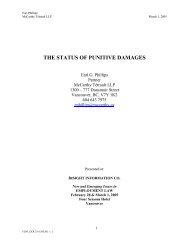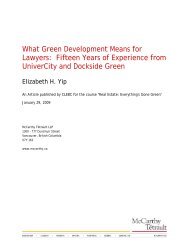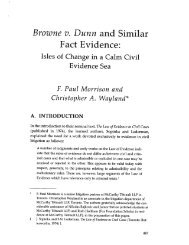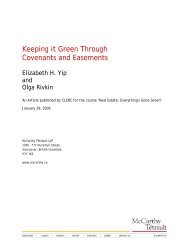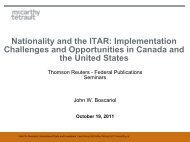The Doctrine of Public Policy in Canadian Contract Law
The Doctrine of Public Policy in Canadian Contract Law
The Doctrine of Public Policy in Canadian Contract Law
You also want an ePaper? Increase the reach of your titles
YUMPU automatically turns print PDFs into web optimized ePapers that Google loves.
40 / Annual Review <strong>of</strong> Civil Litigation<br />
prevail<strong>in</strong>g social conditions.208 Accord<strong>in</strong>g to the consensus theory, the courts<br />
are <strong>in</strong>deed permitted to embrace new heads <strong>of</strong> public policy, as its very content<br />
is to be determ<strong>in</strong>ed by a set <strong>of</strong> majoritarian preferences which are constantly <strong>in</strong><br />
flux.209 One <strong>of</strong> the lead<strong>in</strong>g proponents <strong>of</strong> the consensus model is Waddams,<br />
who states that "[the] categories reflect the values <strong>of</strong> the era. An evolv<strong>in</strong>g society<br />
must... have chang<strong>in</strong>g values, and the law fails <strong>in</strong> its service to society if it<br />
cannot also evolve".''"<br />
<strong>The</strong> third traditional theory <strong>of</strong> public policy is <strong>in</strong>timately concerned with<br />
the <strong>in</strong>dividual moral conception <strong>of</strong> the judge. This is a view sometimes referred<br />
to as the "<strong>in</strong>terstitial legislator" model,'" and is the most popular theory among<br />
the doctr<strong>in</strong>e's various commentators:2'2 Simply put, the idea is that public policy<br />
is formulated <strong>in</strong> accordance with the subjective beliefs <strong>of</strong> the court regard<strong>in</strong>g<br />
which values are ultimately <strong>of</strong> the most importance to society. Although the<br />
actual criteria for such a judicial determ<strong>in</strong>ation is never truly def<strong>in</strong>ed <strong>in</strong> the<br />
208 As Cheshire, supra note 7 at 408 notes: "[Once public policy reflects the mores and<br />
fundamental assumptions <strong>of</strong> the community, the content <strong>of</strong> the rules should vary from<br />
country to country and from era to era." See also Symmons, supra note 17 at 189, stat<strong>in</strong>g<br />
that "[t]he essential function.. . <strong>of</strong> public policy <strong>in</strong> the common law is to br<strong>in</strong>g <strong>in</strong>to<br />
judicial consideration the broader social <strong>in</strong>terest <strong>of</strong> the public at large." A judicial<br />
affirmation <strong>of</strong> the consensus model may be found <strong>in</strong> Tank L<strong>in</strong><strong>in</strong>g Corp. v. Dunlop<br />
Industries Ltd. (1982), 40 O.R. (2d) 219, 1982 CarswellOnt 780 (C.A.) at para. 10, cit<strong>in</strong>g<br />
Vancouver Breweries Ltd. v. Vancouver Malt & Sake Brew<strong>in</strong>g Co., [1934] A.C. 181<br />
(British Columbia P.C.) at 189. <strong>The</strong> consensus model addresses the constitutional question<br />
<strong>of</strong> whether the courts have any jurisdiction to ground their decisions on someth<strong>in</strong>g<br />
other than the positive law on the basis that, ". . .there is a qualitative, rather than simply<br />
a quantitative, difference between the work <strong>of</strong> the courts, and that <strong>of</strong> the legislature...<br />
the judge acts <strong>in</strong> a 'neutral' way <strong>in</strong> mak<strong>in</strong>g rules, whereas the legislators and the executive<br />
are more partisan... and he can do that only if his views are not idiosyncratic, and his<br />
whole demeanour commands the respect <strong>of</strong> the whole community" (Bell, supra note<br />
198 at 11).<br />
209 An important qualification <strong>of</strong> the model is made by Bell, supra note 198 at 12, who<br />
notes that "'consensus' <strong>in</strong> this context does not so much mean public op<strong>in</strong>ion as the<br />
fundamental values and purposes <strong>of</strong> society. . ."<br />
210 Waddams, supra note 4 at 395. A famous example <strong>of</strong> this pr<strong>in</strong>ciple may be found <strong>in</strong><br />
Bowman v. Secular Society Ltd., [1917] A.C. 406 (H.L.) at 447-452, where the <strong>Law</strong><br />
Lords departed with prior jurisprudence <strong>in</strong> hold<strong>in</strong>g that a gift to a company with an anti-<br />
Christian memorandum <strong>of</strong> association was not <strong>in</strong>valid by reason <strong>of</strong> public policy.<br />
2 I 1 This term is also taken from Bell, supra note 198.<br />
212 Among its adherents are W<strong>in</strong>field, Knight, and Shand. <strong>The</strong> belief that public policy is<br />
<strong>in</strong>dicative <strong>of</strong> a general legislative tendency with<strong>in</strong> the judicial function is obviously at<br />
odds with the criticism <strong>of</strong> the doctr<strong>in</strong>e as a constitutionally illegitimate <strong>in</strong>trusion by the<br />
courts <strong>in</strong>to the prov<strong>in</strong>ce <strong>of</strong> the legislature. <strong>The</strong> theory's response to such a claim is<br />
conditioned by the adjective "<strong>in</strong>terstitial," which <strong>in</strong>dicates that the proper role <strong>of</strong> the<br />
courts is to supplement the laws handed down by Parliament rather than to create their<br />
own. Thus, "[w]hile the value-judgments to be made by judges... are essentially <strong>of</strong> the<br />
same k<strong>in</strong>d as those confront<strong>in</strong>g other branches <strong>of</strong> government, judicial creativity operates<br />
with<strong>in</strong> narrower conf<strong>in</strong>es, and this feature accounts for the differences between them"<br />
(Bell, supra note 198 at 226).




